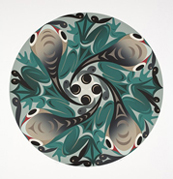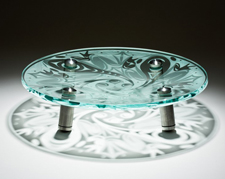Current Exhibit – Places of British Columbia
Works on loan courtesy of the Salish Weave Collection
http://salishweave.com
Spirit of Taku Susan Point, 2004
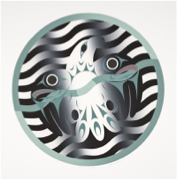
The Taku River runs from British Columbia to the northwestern coast of North America, at Juneau, Alaska. At its mouth is the British Columbia-Alaska border. The river basin spreads across 27,500 square kilometers (10,600sq mi).
During the 18th and early 19th centuries, the Taku Indians controlled the trade routes on the river and compelled natives of the Interior to use them as middle-men, instead of allowing trade directly with white settlers. One account of its name is that “Taku” is the Tlingit language word for “salmon”. The Taku River is an important contributor to the economies of British Columbia and Southeast Alaska, especially for its fisheries.
After the Fraser and Skeena Rivers, the Taku is the largest salmon-producing river in Canada. Nearly 2 million wild salmon return to the river annually, including up to 100,000 Chinook salmon (king salmon), 350,00 Sockeye salmon (red salmon), 400,000 Coho salmon (silver salmon), 50,000 Chum salmon (dog salmon) and 1 million Pink salmon (humpy salmon).
Besides its bounty of salmon, the Taku is home to eight other fish species: steelhead, bull trout, Dolly Varden char, rainbow trout, lake trout, arctic grayling, whitefish and Southeast Alaska’s largest population of cutthroat trout. In addition, hooligans (eulachon), crab, shrimp and halibut are harvested at or near the river’s mouth. This marine wealth supports major sport, commercial and tribal fisheries in British Columbia and Alaska.
Northern Lights Susan Point, 2008

Notes
The further North, the better.
Not a rare occurrence in BC
Seen in:
Cariboo region (Quesnel, Wells, Barkerville, Prince George and numerous lake areas) Fort St-John Terrace, Peace River Region – Dawson Creek where the Northern Lights College is located.
See www.nlc.bc.ca
Cariboo Region – Quesnel, Thomas Cannell, 2013
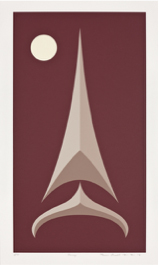

The two most recent works I created are based on the elements most commonly used in Salish visual interpretation. I have taken these shapes further by creating imagery using only three shapes.
For Harmony, I have created a lone evergreen lit by moonlight. The inspiration for the image came from long nights in the wide-open plateaus of the Cariboo; skies filled by a moon which rises and sets like the sun, reflecting off snow covered trees.
Illume was inspired by a massive full moon that lit the edge of the forest, creating a chiaroscuro effect on the tree line. Still, what I see are Salish elements from the shapes within.
Both of these prints are a celebration of the Salish form, and the rich, deep colors are a symbol of my people’s legacy.
Confluence: Where the Thomson Meets the Fraser Susan Point, 2009
Fraser River and Thompson River Canyons
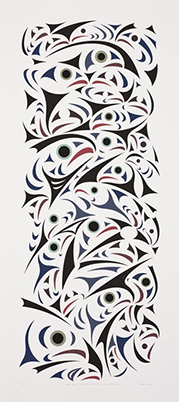
The Thompson River, home to many species of game fish as well as to the largest and strongest steelhead of North America, is one of the major tributaries of the Fraser. It was named after David Thompson, an explorer and topographer with the Northwest Trading Company.
The Fraser River is the longest river in British Columbia, flowing for 1,375 kilometers (854 mi), and the tenth longest in Canada. The Fraser is known for the fishing of white sturgeon. A typical white sturgeon catch averages between 30 to 100 pounds. It is named after Simon Fraser, who led an expedition on behalf of the North West Company from the site of present-day Prince George to the mouth of the river.
The Thompson River joins the Fraser River at Lytton, the capital of river rafting. The river canyons, knows as the Dry Belt region of British Columbia, are world famous for whitewater rafting, kayaking, sport fishing, outdoor adventures and very hot summers.
Whistler
Whistler Susan Point, 2009
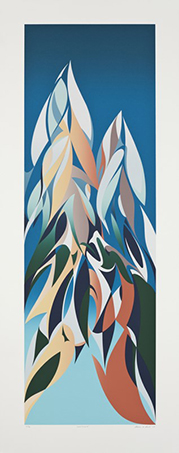
Nestled in the southern Pacific Ranges of the Coast Mountains, Whistler is a resort town located on Highway 99, also known as the Sea-to-Sky highway. It is only 40 kilometers inland from the Pacific Ocean and about 125 kilometers (78 mi) north of Vancouver.
Whistler has a permanent population of close to 10,000 people and a larger transient population of typically younger workers. It welcomes over two million visitors annually, primarily for alpine skiing and snowboarding and, in the summer, for mountain biking.
Whistler has been voted among the top ski destinations in North America since the mid-1990s and its pedestrian village has won numerous design awards. During the 2010 Winter Olympics, it hosted most of the alpine and Nordic skiing events, as well as the sliding events: luge, skeleton and bobsled.
The pristine natural environment and untamed wilderness of the Whistler Valley also attracts visitors. Every spring, waterfalls pour out from mountaintops and cascade over giant cliffs. Its majestic glaciers are accessible by helicopters, providing visitors with unique hiking and skiing experiences.
Bears, cougars, deer, marmots, rabbits, birds, eagles and fish make their home in the Whistler Valley. In fact, the marmot gave Whistler its name. Its shrill whistles warn other marmots of potential danger and their calls can be heard throughout Whistler and Blackcomb Mountains where they live.
Garibaldi Provincial Park – Black Tusk
Over Black Tusk, Susan Point, 2005
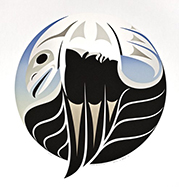
Garibaldi Provincial Park is a wilderness park located about 70 kilometers (43.5 mi) north of Vancouver, east of the Sea-to-Sky Highway between Squamish and Whistler. It covers an area of over 1,950 square kilometers (753 sq mi).
Black Tusk is a strata-volcano and a pinnacle of volcanic rock in the Garibaldi park. At 2,319meters (7,608 ft) above sea level, the upper spire is visible from a great distance and in all directions. It is particularly noticeable from the Sea-to-Sky highway just south of Whistler. Distinctive and immediately identifiable, the Black Tusk is among the best known mountains in the Garibaldi Ranges of the Coastal Mountains.
To Squamish people, this mountain is known as the “Landing Place of the Thunderbird”. Thunderbird is a revered supernatural creature. The jagged shape of the mountain and its black coloring are said to come from the Thunderbird’s lightning.
Fraser River Delta
Susan Point, 2011
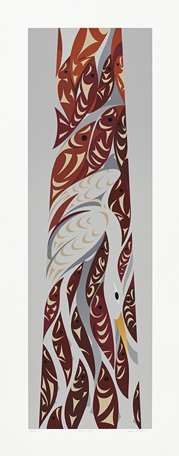
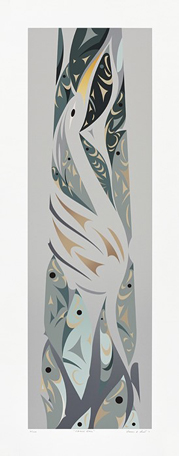
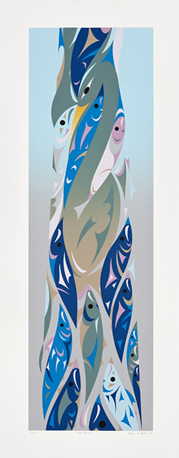
The artwork of these 3 limited edition serigraphs is based on a public art commission for the 2010 Olympic skating oval in Richmond BC. These are further explorations of the design that is incorporated into the structural buttresses that support the building.
The imagery in the artwork reflects the ever-changing Fraser. Incorporated within the delta theme are heron motifs. The contours are revealed by salmon motifs in the foreground. Richmond has chosen the heron as its ambassador; herons have chosen the delta as their home for countless generations.
Musqueam Reserve
Musqueam Foreshore Susan Point, 2012
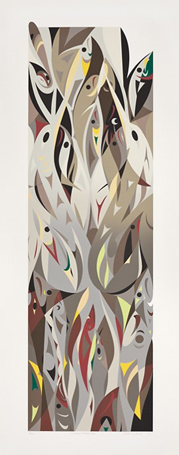
The Musqueam people have lived in our present location for thousands of years. Our traditional territory once occupied much of what is now Vancouver and surrounding areas.
The name Musqueam relates back to the River Grass whose name is məθkʷəy. A story passed on from generation to generation explains that in some periods the məθkʷəy̓ grass flourished, and in some periods it could scarcely be found and that that in some periods our people would flourish and in some periods the population would dwindle, perhaps by plague or war. It was in this way that we became known as the xʷməθkʷəyəm (Musqueam) – People of the River Grass.
We are traditional hənqəminəm speaking people and descend from the cultural group known as the Coast Salish. Although a metropolitan city has developed in the heart of Musqueam territory, our community maintains strong cultural and traditional beliefs. Today our population flourishes and we are a strong community of over thousand members. We live on a very small portion of our traditional territory, known as the Musqueam Indian Reserve, located (in the West end of Vancouver), south of Marine Drive, near the mouth of the Fraser River.
Edited excerpts from the Musqueam home page at www.musqueam.bc.ca
Anvil Island
Anvil Island – Susan Point, 2013
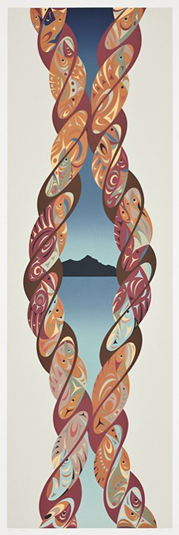
Anvil Island is the third largest of the islands in Howe Sound, British Columbia, Canada, and the northernmost of the major islands in that sound. It is located northeast of Gambier Island, southwest of Britannia Beach and west of Porteau Cove.
Vancouver
Stanley Park Portals Crosswalk and The Inlet, Susan Point, 2007
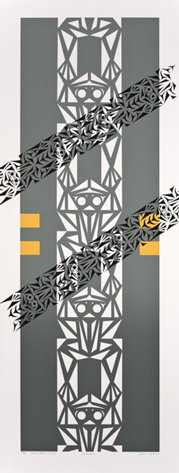
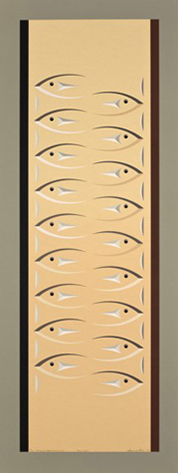
Manhole Covers Stanley Park Portals Crosswalk
and The Inlet, Susan Point, 2007
